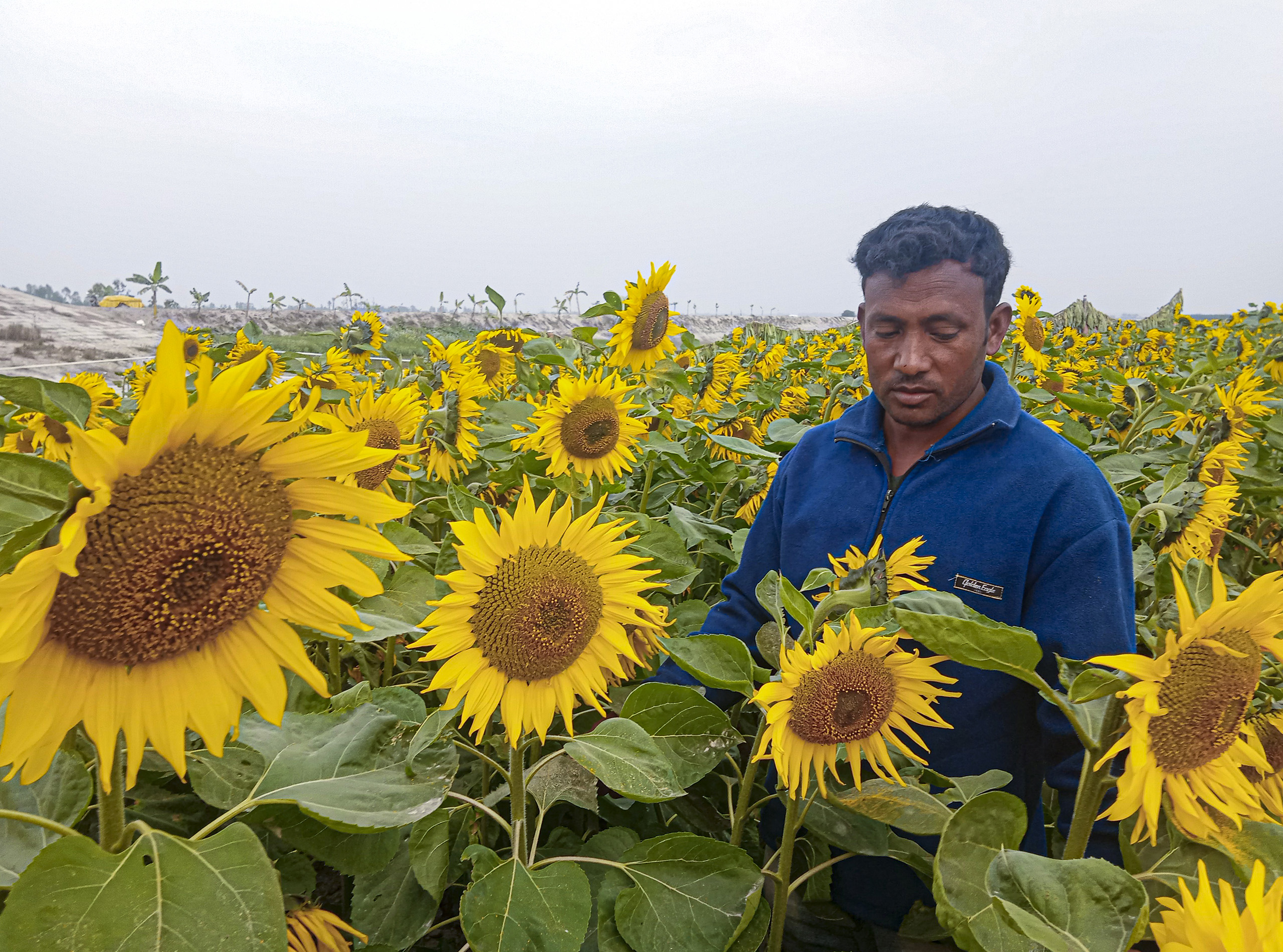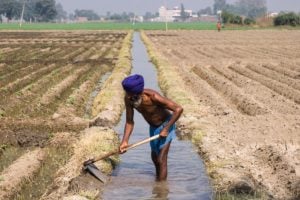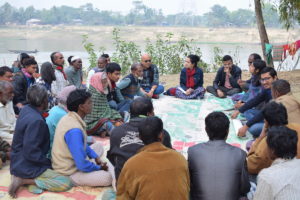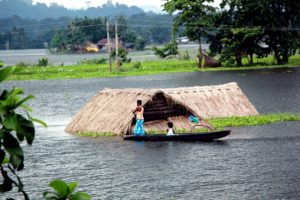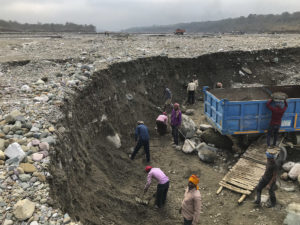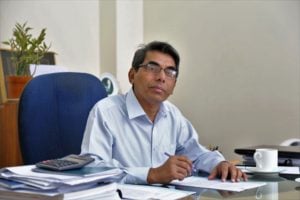Until five years ago, 62-year-old Montu Barman had never thought of farming anything other than tobacco and rice. A resident of Dangapara village in Rangpur district of northern Bangladesh, Barman barely made ends meet when he was relying on the crops he and his peers had always grown. His fortunes turned when he started a small tea garden.
“I have never seen such profit by cultivating paddy and tobacco,” Barman tells The Third Pole. “Tea cultivation has increased my income.”
Barman’s tea garden is now spread over 0.6 hectares. This is a very small plot by commercial tea garden standards, in Bangladesh or elsewhere. But since the late 1990s, more and more farmers like Barman have begun growing tea over small plots and selling their produce to larger companies. Tea, maize, sunflower and mustard are replacing tobacco farming in Rangpur, Lalmonirhat, Nilphamari and Gaibandha districts – all in the Teesta basin.
Crucially, these crops need less water than tobacco, Tahsina Sharmin Hoque, professor at the Department of Soil Science at Bangladesh Agriculture University, told The Third Pole.
The Teesta River flows into Bangladesh from India. Dams built for hydroelectricity in India have reduced downstream water levels during the eight non-monsoon months of the year. Bangladesh has long been asking for a water sharing agreement, to no avail. Faced with increasing water pressure, farmers and agricultural experts realised they would need to move to less thirsty crops than tobacco.
Apart from tea, the Bangladesh government has been pushing farmers to grow sunflower, mustard and maize in this region, through distribution of seeds and training on how to grow these crops.
Alternative crops offer better profits
Barman made a profit of BDT 300,000 (USD 3,485) from his tea garden in 2021, after seedlings, fertilisers and labour cost him about BDT 120,000 (USD 1,394). This is more than twice the profit he used to make from tobacco. Barman says he will increase the acreage under tea. “I will not return to tobacco.”

Barman’s village is in Taraganj sub-district. Speaking on the condition of anonymity, an official from the sub-district agriculture department confirms that farmers in the area were totally dependent on tobacco cultivation until around five years ago. It has changed since then, but slowly. The official says that the area of tobacco cultivation fell from 950 hectares in 2020 to 650 hectares in 2021. Meanwhile, the area of mustard rose from 75 hectares in the winter of 2020-21 to 250 hectares in 2021-22.
Mahabub Alam, a farmer in Jagadishpur village of the same sub-district, tells The Third Pole, “Tobacco cultivation requires extreme hard labour. The yield of the new variety of mustard is much better and cost is also low. There is no such hard work, and the plants do not get infected by insects. Therefore, I cultivated mustard instead of tobacco in a part of my farm.” He also calculated that irrigating his mustard patch costs less than half of what he used to spend irrigating a tobacco patch of the same size.
Shahin Hossain, a resident of Mahipur village in the same district, has decided to shift from tobacco to sunflower cultivation. He has spent BDT 50,000 (USD 580.92) buying saplings and fertiliser, and is hopeful of making a handsome profit, Hossain told The Third Pole.
No future for tobacco growers
Tobacco cultivation in the Teesta River basin began in the 1970s. Farmers used to make hefty profits selling to tobacco companies. But tobacco is a water-guzzling plant.
Profit from tobacco farming evaporated in Bangladesh as the water level in the Teesta came down and groundwater levels fell. According to the latest report from the Bangladesh Bureau of Statistics, Rangpur remains one of the poorest regions in the country. The area has a Teesta irrigation project, but its effectiveness is limited due to lack of water in the river. Plus, the area is prone to river erosion, as shown in a recent countrywide disaster mapping exercise by the Asian Development Bank.
Farmers in northern Bangladesh should grow crops that need less water. Maintaining soil moisture is very important to prevent river erosionChowdhury Sarwar Jahan, Rajshahi University
Chowdhury Sarwar Jahan, a professor in the department of geology and mining of Rajshahi University emphasises how maintaining soil moisture is important to prevent river erosion. Farmers in the region should grow crops that need less water, he tells The Third Pole.
“In Greater Rangpur, with the help of Department of Agricultural Extension (DAE) the farmers are shifting from tobacco to other crops, which is good news for nature and human beings,” says Jahan. He thinks this will help raise groundwater levels in the region.
161,000
People die every year in Bangladesh from tobacco-related diseases
The area under tobacco cultivation in Rangpur division – which includes the districts Rangpur, Gaibandha, Lalmonirhat and Nilphamari – has decreased significantly in recent years. Dr Mehedi Masud, director of the Department of Agricultural Extension, told the The Third Pole that acreage fell from 14,000 hectares in 2016-17 to 11,000 in 2020-21, and that annual production has gone down from 30,000 to 14,000 metric tons.Obaidur Rahman Mandal, deputy director of the DAE in Rangpur district, tells The Third Pole that sunflower is now being cultivated in almost all sub-districts, and DAE is encouraging farmers to quit tobacco farming to save groundwater.
Apart from being water-intensive, tobacco breaks down soil nutrients faster than most other crops. A 2017 study by the World Health Organisation (WHO) pointed out that the tobacco plant consumes two and a half times more nitrogen, seven times more phosphorus and six times more potassium than maize. This makes it more difficult to farm on soil on which tobacco has been grown.
Tobacco-free Bangladesh
Sheikh Hasina, Prime Minister of Bangladesh, had pledged at a South Asian Speakers’ conference in January 2016 that the country would be tobacco free by 2040. While the government has strict tobacco control laws in place, the WHO said in 2019 that 35% of the population of Bangladesh uses tobacco, which kills 161,000 people annually in the country and creates medical expenses of BDT 305.6 billion (USD 3.6 billion). A study published in 2015 found that apart from users, 29% of tobacco farmers have asthma and 33% suffer from a persistent cough due to tobacco fumes inhaled during the process of curing leaves.
Hossain Zillur Rahman, eminent economist and executive chairman of the think tank Power and Participation Research Centre (PPRC) tells The Third Pole that tobacco farming was so widespread in Bangladesh earlier because the government’s revenue department used to encourage it. He is glad the situation has changed. “Now it is time to take a firm stand on tobacco alternatives at the policymaking level.”
